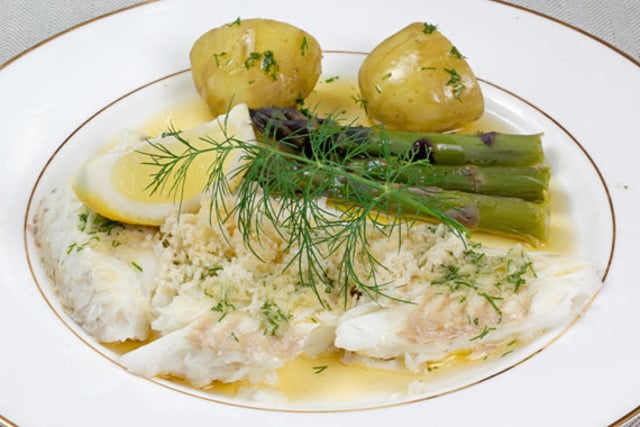Swedes normally bake medium-sized fish, such as arctic char, and large flat fish, such as brill and turbot, very slowly. To quote from Vår Kok Bok, Sweden's top-selling cookery book, “The skin dries and protects the flesh, sealing in the flavour…”
Though brill availability is limited due to overfishing, it can easily be substituted by turbot for example. In fact, both are so closely related that they sometimes interbreed. Brill is slightly less meaty than turbot, though sweeter, and has a wonderful texture.
Summary
Makes: 2-4 servings
Level: Very Easy
Preparation: 5 minutes
Cooking: 55 minutes/kg
TOTAL: 1-2 hours
Tips
– Allow about 350 g (12 oz), per person, so a small 700 g (1½ lb) fish will serve 2. A medium sized fish of about 1.5kg (3 lb), will serve 4.
– When choosing brill, look for bright eyes, but don’t worry about the colour of the skin as this depends on where they are caught, ranging from light brown on sandy sea floors to dark, rich chocolate-brown on muddy substrates.
– You can use hot horseradish sauce if you can't get fresh horseradish. (Fresh horseradish will keep for several weeks in a fridge if wrapped in clingfilm.)
– Serve the fish quite simply with boiled or steamed potatoes, melted or brown butter, freshly grated horseradish and a few steamed vegetables or a salad.
Ingredients
1 whole brill, cleaned
30g (2tbsp) butter per person
2 tbsp freshly grated horseradish per person
lemon wedges, optional
dill springs, optional
Method
1. Preheat the oven to 100°C (210°F, gas ¼, fan 100°C).
2. Weigh the fish and calculate the cooking time based on 55 minutes/kg (25 minutes/lb), or a minimum of 50 minutes.
3. Rinse the fish and then dry with paper towels.
4. Place in the pan, dark side upwards, and roast for the calculated time. (Don’t add any liquid, butter or oil.)
5. While the fish is cooking, melt the butter slowly. Skim off all the froth from the surface. You will then see a clear yellow layer on top of a milky layer. Discard the milky residue and use the rest. Carefully pour into a hot sauce boat and keep warm until required. (If you prefer beurre noisette (brown butter), follow the recipe below.)
6. At the end of the calculated cooking time, check that the fish is cooked by pushing the tip of a round-ended knife through the thickest part of the flesh until it touches the backbone, then lever it gently to one side. If the fish is cooked it should come away from the backbone easily and the flesh should be white and opaque. (If you have a temperature probe, the temperature of the thickest part should be 55C-58C (131-136F).)
7. Serve the fish straight from the roasting pan by making a cut in the skin along the backbone, remove the skin and serve the fillets on to hot plates. Top the fillets with grated horseradish, pour over a little of the juices from the pan and some melted or brown butter and garnish as desired. Serve the remaining melted or brown butter in a sauce boat along with a dish of grated horseradish.
Beurre noisette
If you prefer to serve the fish with beurre noisette (brown butter) it is fairly easy to do if you follow the tips below. The idea is that the butter is heated a little past its melting point, which results in the milk solids in the butter browning and creating a wonderful nutty aroma.
1. Heat a thick bottomed saucepan on medium heat. Add the butter cut into slices or cubes so that it heats evenly and all the butter melts at the same time.
2. Once the butter has melted whisk it frequently. It will produce quite a lot of white foam initially, but then the foam will begin to subside.
3. Continue whisking and heating the butter, but watching it carefully. Lightly browned specks will begin to form at the bottom of the pan and it will give off a gorgeous nutty aroma.
4. Once the butter is a rich golden colour and has a nice nutty aroma, remove the butter from the heat to stop it from cooking any more, and pour it carefully into a warmed sauce boat, discarding the residues.
Butter is easy to brown provided you watch it carefully and keep whisking it. If you neglect it and end up overcooking it, so that the butter becomes black, I am afraid you will have to discard it and start again!
This recipe is published courtesy of John Duxbury, founder and editor of Swedish Food.



 Please whitelist us to continue reading.
Please whitelist us to continue reading.